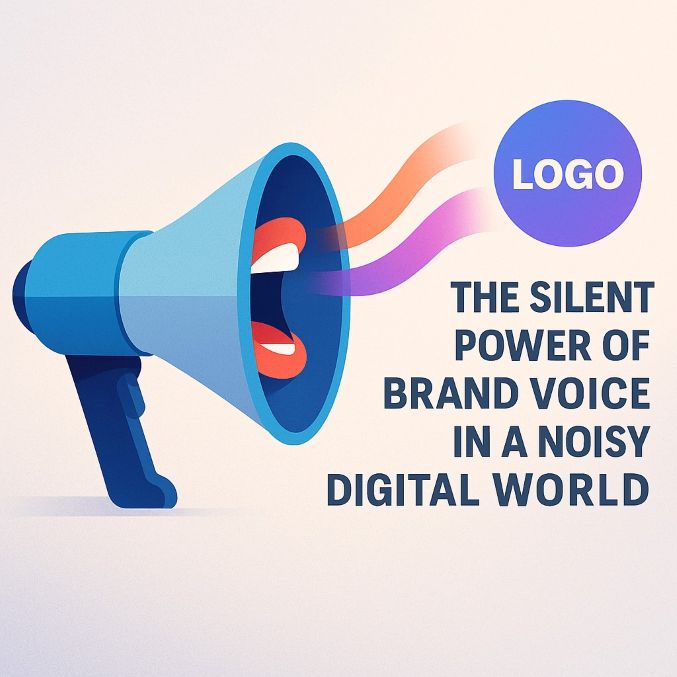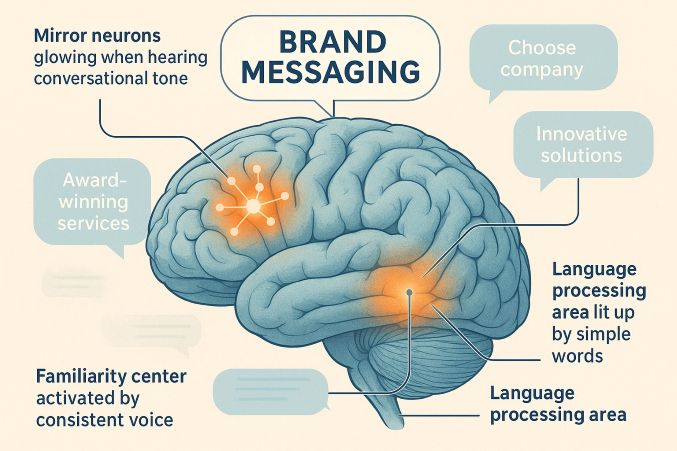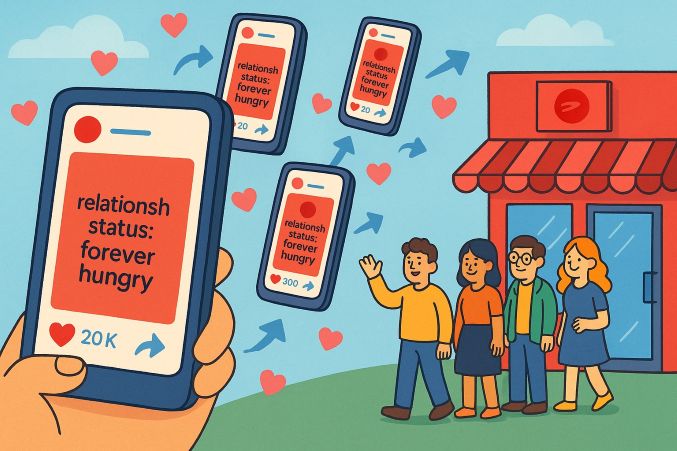Why Your Brand Voice Is More Important Than Your Logo: The Ultimate Guide
In this oversaturated digital market, where consumers are exposed to thousands of brand messages every day, differentiation takes more than an attractive-looking logo. While a great-looking logo is the face of your brand, it's your brand voice—the unique personality, tone, and language you speak in communications—that most accurately forms customer perceptions, builds emotional connections, and creates long-term loyalty.
A logo is a silent mark, but your brand voice is the dialogue—it's how you welcome customers, respond to their inquiries, communicate your values, and stand apart from others. In an age when consumers favor more human, relatable, and authentic brands, your voice isn't a component of your branding—it is your branding.
Let's dive in deep into why your brand voice trumps your logo—and how you can hone it to build lasting impression.

1. The Silent Power of Brand Voice in a Noisy Digital World
Why Tone, Language, and Consistency Make a Deeper Impression Than Design
We reside in a period of perpetual digital din. Millions of tweets, advertisements, e-mails, and social updates vie for attention each second. A trendy logo may get you noticed for a moment, but it's your brand voice that makes them linger, interact, and recollect.
- Tone Sets the Mood – Are you approachable? Authoritative? Fun? Sarcastic? Your tone defines the way customers understand your brand personality.
- Language Builds Relatability – Using slang, industry jargon, or formal language can either attract or alienate your audience.
- Consistency Creates Recognition – Just as McDonald’s golden arches are instantly recognizable, a consistent brand voice makes your messaging unmistakable.
Real-World Example:
- Innocent Drinks doesn’t just sell smoothies—they entertain with quirky, conversational copy on their packaging and social media. This makes them feel like a friend rather than a corporation.
- Zomato's snarky, meme-based tone on Twitter transforms boring food delivery announcements into going-viral engagement.
Key Takeaway:
A logo is observed, but a brand voice is experienced. And in branding, feelings make decisions a thousand times more than images alone.

2. Brand Voice vs. Visual Identity: What Creates Long-Term Trust?
A Comparative Analysis of Emotional vs. Aesthetic Branding
Most companies spend big bucks on logos, colors, and typography, believing these aspects are the core of their brand. However, although visual identity aids in recognition, it's brand voice that facilitates trust, loyalty, and emotional connection.
|
Aspect |
Visual Identity (Logo, Colors, Design) |
Brand Voice (Tone, Messaging, Personality) |
|
Primary Role |
Creates instant recognition |
Builds emotional connection & trust |
|
Longevity |
Can become outdated with trends |
Evolves naturally with culture & audience |
|
Engagement Level |
Passive (seen but not interacted with) |
Active (sparks conversations & loyalty) |
|
Memorability |
Helps recall (e.g., Nike Swoosh) |
Makes brands feel human (e.g., Wendy’s roasts) |
Case Studies:
- Apple – Their logo is iconic, but it’s their minimalist, aspirational messaging ("Think Different") that cements their brand ethos.
- CRED – Their exclusive, witty tone (e.g., "Stop paying bills like a peasant") reinforces their premium positioning better than any logo could.
Why This Matters:
Consumers don't buy from logos—they purchase from brands they trust, identify with, and believe in. And that can happen only through consistent, genuine communication.
3. How a Unique Brand Voice Fuels Engagement and Loyalty
Case Studies from Brands Such as Zomato, CRED, and Duolingo
A robust voice doesn't only get noticed—it converts casual fans into passionate champions. Here are some of the most well-known brands leveraging voice to drive engagement, retention, and word-of-mouth marketing.
Brands Winning with Voice:
- Zomato – Their pugnaciously sarcastic, meme-filled tone on social media stands out amidst the food delivery app noisiness.
- Duolingo – The playful, sometimes zany owl personality (paired with TikTok humor) keeps users hooked beyond language learning.
- CRED – Their snobbish but clever tone ("Your credit score is higher than your ex's standards") makes financial services surprisingly fun.
Why Voice = Higher Engagement
✅ Relatability – Consumers prefer brands that sound like real people, not corporate robots.
✅ Memorability – A distinctive voice stands out in the noise of crowded markets.
✅ Loyalty – Consistency builds familiarity and trust, leading to repeat sales.
Data-Backed Insight:
- 64% of customers indicate that common values (expressed through brand voice) are the reason they stick with a brand (Edelman Trust Barometer).
- 3x more social media mentions for brands with high voice strength compared to generic competitors (Sprout Social).
Key Lesson:
Your logo makes you seen, but the voice makes you remembered, followed, and loved.

4. The Psychology Behind Brand Communication
How Human-Like Voice Creates Familiarity and Evokes Retention
Our minds are programmed to react to human-like speech. A carefully designed brand voice hits emotional psychological triggers that drive recall, trust, and emotional bond.
Science-Backed Reasons Why Voice Is Important:
- Familiarity Effect – Consumers like brands that make them feel at home (like a friend, not a stranger).
- Mirror Neurons – Tonal dialogue unconsciously creates rapport, making buyers feel heard.
- Cognitive Ease – Easy, familiar language is processed more quickly, making your brand more endearing.
Brands That Get Psychological Branding Right:
- Slack – Employing conversational, jargon-free language helps technology feel accessible.
- Tesla – Their ambitious, futuristic voice ("Accelerating the world's transition to sustainable energy") resonates with their audience's ambitions.
- Dove – Their uplifting, universal language supports their "Real Beauty" cause.
Why This Works:
A logo is merely a picture—but a brand voice directly addresses the mind and heart, making your messaging stickier and more convincing.
5. Voice Consistency Across Channels: The Key to Omnichannel Branding
From Instagram Captions to Email Campaigns—Why Your Tone Needs to Travel Effortlessly
Your brand voice must be immediately identifiable, whether a customer is talking to you on Twitter, via email, customer support, or advertising. Inconsistency confuses audiences, whereas consistency makes recall and trust stronger.
How to Keep a Consistent Brand Voice Everywhere:
- Develop a Brand Voice Guide – Write down your tone, words, and messaging do's & don'ts.
- Train Your Team & Freelancers – Have everyone (marketing, sales, support) adhere to the same style.
- Audit Content Regularly – Verify deviations in tone between platforms.
Brands Doing This Right:
- Netflix – Whether they're tweeting memes or emailing, their snappy, clever tone remains consistent.
- Mailchimp – Their welcoming, assistive voice remains constant in blogs, commercials, and customer support.
The Impact of Consistency:
- 20% greater customer retention for brands with a consistent voice (Forrester Research).
- 15% revenue boost from omnichannel consistency (Aberdeen Group).
Final Takeaway:
A fragmented voice undermines your brand, but a unified, recognizable voice establishes trust, loyalty, and long-term development.

6. Typical Mistakes Brands Make with Their Voice (And How to Correct Them)
Why Jargon, Inconsistency, and Tone-Deaf Humor Hurt Your Brand
Most brands know the value of voice but still fall short in implementation. The following are the most common mistakes and how to steer clear of them:
Mistake #1: Excessive Use of Corporate Jargon
Problem: Phrases like "leverage synergies" or "disruptive paradigm shifts" make brands sound robotic.
Fix: Write like you speak. Example: Instead of "utilize," say "use."
Mistake #2: Inconsistent Tone Across Platforms
Problem: Formal on LinkedIn, slang-heavy on Twitter—confusing audiences.
Fix: Create a brand voice guide with clear dos and don’ts for each channel.
Mistake #3: Trying Too Hard to Be "Trendy"
Error: Enforced Gen Z slang (e.g., "no cap, this product bussin'") is unnatural.
Solution: Only implement trends that organically align with your brand.
Mistake #4: Disregarding Feedback from Your Audience
Error: Failure to tone down when customers tell you that you sound "out of touch."
Solution: Continuously poll customers and A/B test language.
Mistake #5: AI Chatbot Over-Personalization
Error: Human-like chatbots ("I'm just a friendly AI! ") have a boomerang effect.
Correct: Be honest—customers prefer it to insincere friendliness.
Case Study:
- Burger King's "Women Belong in the Kitchen" Tweet – Tried to be edgy humorous but was heavily criticized. Lesson: Understand the limits of your audience.
7. Why Gen Z and Millennials Are Attracted to Personality Brands
Data-Driven Insights on Conversational Branding in 2025
Younger consumers don't merely purchase products—they invest in brand personalities. Here's why:
Key Stats on Gen Z & Millennial Preferences:
- 72% say they’re more loyal to brands with a distinct personality (Morning Consult).
- 65% trust brands that use informal, relatable language (YPulse).
- 58% have unfollowed brands for sounding "too corporate" (Sprout Social).
What Works for Younger Audiences?
✅ Self-Deprecating Humor – Duolingo’s "We know you’re not learning Spanish, but keep opening the app."
✅ Meme Culture – Wendy’s roasts and Netflix’s viral tweets.
✅ Authentic Storytelling – Glossier’s user-generated content feels personal, not salesy.
Brands Winning with Gen Z:
- Chipotle – TikTok challenges + clever responses = 10M+ engaged fans.
- Gymshark – Fitness memes + authentic athlete tales = cult-like devotion.
Takeaway:
If your brand is a hilarious, smart friend, Gen Z and Millennials will care.
8. Creating a Brand Voice Guide: Templates and Frameworks
How to Develop a Scalable Voice Document for Teams & Freelancers
A brand voice guide assures that everyone, from marketers to customer support, talks in a single, consistent tone.
Key Parts to Have:
- Brand Personality Traits (e.g., "Friendly but professional, like a mentor")
- Tone Examples (How you sound when you're happy vs. in crisis situations)
- Word Bank (Approved words + banned jargon)
- Channel-Specific Rules (LinkedIn vs. TikTok tone differences)
Free Template Format:
markdown
1. **Our Voice in 3 Words:** [e.g., "Warm, Expert, Playful"]
2. **Do's & Don'ts:**
- Do: "Use contractions (you’re vs. you are)"
- Don’t: "Sound robotic (‘Please be advised’)"
3. **Example Messaging:**
- Formal: "We appreciate your patience."
- Casual: "Thanks for hanging tight!"
Brands with Great Voice Guides:
- Mailchimp – Their guide is public (and a masterclass in friendly professionalism).
- Spotify – Makes playlists and commercials sound cool every time.
Pro Tip:
Try your guide with genuine customer feedback—do they identify your brand blindfolded?
9. Brand Voice in AI-Generated Content: How to Maintain Authenticity
Maintaining Your Tone Human in ChatGPT, Copy.ai, and Beyond
AI tools may scale content, but they can leave the personality behind. Here's how to retain your voice:
5 Strategies for AI-Assisted Brand Voice
- Feed AI Your Best Samples – Input previous blogs/social posts to train the tone.
- Use Custom Instructions – E.g., "Always sound conversational, not academic."
- Edit Ruthlessly – AI drafts should be 60% ready—human polish makes them 100%.
- Avoid Generic Phrases – Substitute "revolutionary solution" with your brand's quirky equivalent.
- Add Human Quirks – Add inside jokes or regional slang if it fits your voice.
Tools to Help:
- Jasper (Brand Voice Chats)
- ChatGPT Custom Instructions
- Copy.ai Brand Tone Settings
Case Study:
- HubSpot's AI Blogging – Drafts using AI but edits in their own signature helpful, positive tone.
Warning:
Too much reliance on AI = generic, unremarkable content. Always inject human touch.
10. Measuring the ROI of Brand Voice: Does It Really Impact Sales?
Real-World Examples Showing How Tone Contributes to Conversion
Does a "fun" or "serious" voice really drive revenue? Let's examine the facts.
Metrics That Prove Voice Matters:
Likes/Shares – Brands with unique voices get 2-3x more likes/shares.
Customer Retention – 44% of customers remain loyal to brands that "get their tone right" (Salesforce).
Conversion Lift – A/B tests confirm personalized, on-brand copy boosts sign-ups by 20%+ (VWO).
Brands with Voice-Driven ROI:
- Dollar Shave Club – Their funny, authentic launch video prompted 12,000 orders within 48 hours.
- Liquid Death – Punk-rock water branding = $100M+ in sales by roasting corporate language.
How to Monitor Your Voice's Effect:
- A/B Test Email Subject Lines (Formal vs. casual).
- Track Social Sentiment – Are folks calling you "fun" or "stiff"?
- Survey Customers – "How would you describe our brand's personality?"
Final Verdict:
A solid brand voice isn't "nice to have"—it drives revenue.
Key Takeaways:
✔️ Steer clear of jargon, inconsistency, and tone-deaf humor.
✔️ Gen Z adores personality—meme, joke, and storytell.
✔️ Document your voice in a shareable guide.
✔️ AI requires human guidance to remain authentic.
✔️ Measure voice ROI by engagement, retention, and conversions.
Elevate your brand voice—because in 2025, silence is brand suicide.
Want Our Free Brand Voice Checklist? [Download Here]
Missed Part 1? [Read Why Brand Voice > Logo]
Follow for more branding deep dives!
SEO Optimized Elements:
- Keywords: "brand voice mistakes," "Gen Z branding," "brand voice guide template," "AI brand voice," "voice ROI"
- Meta Description: "Discover how to avoid brand voice mistakes, engage Gen Z, create a voice guide, use AI authentically, and measure voice ROI."
- Internal Links: Part 1 + checklist
- Engagement Boosters: Stats, templates, case studies.
Need even more depth on a section? Let me know!


Comments
No Comments To Display